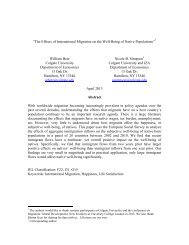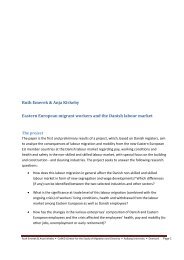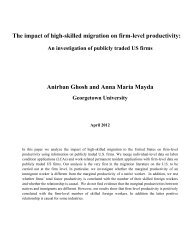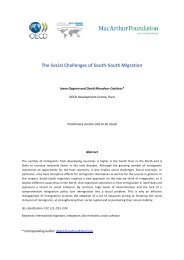The Role of Source- and Host-Country Characteristics in ... - CReAM
The Role of Source- and Host-Country Characteristics in ... - CReAM
The Role of Source- and Host-Country Characteristics in ... - CReAM
You also want an ePaper? Increase the reach of your titles
YUMPU automatically turns print PDFs into web optimized ePapers that Google loves.
migrat<strong>in</strong>g. For first-generation immigrants, work experience prior to their arrival <strong>in</strong> the<br />
host country might be positively correlated with the source-country’s FLFPR. If this is<br />
true, than the estimated effect <strong>of</strong> the latter does not only reflect the role <strong>of</strong> source-country<br />
culture, but partly conta<strong>in</strong>s the effect <strong>of</strong> the level <strong>of</strong> job-related human capital accumulated<br />
before migration. Hav<strong>in</strong>g <strong>in</strong>formation on the human capital <strong>and</strong> labor supply <strong>of</strong> the<br />
immigrant’s parents can help to solve this problem, as parental economic behavior <strong>in</strong> the<br />
source country may serve as a proxy for the child’s labor supply before migrat<strong>in</strong>g.<br />
<strong>The</strong> estimation results <strong>of</strong> models (2) <strong>and</strong> (3) <strong>in</strong>clud<strong>in</strong>g controls for the parents’ highest<br />
level <strong>of</strong> education <strong>and</strong> their labor market status when their daughter was 14 years are<br />
displayed <strong>in</strong> Table 5.<br />
5.3 Ratio <strong>of</strong> FLFP rate to MLFP rate as a proxy for sourcecountry<br />
culture<br />
A possible concern when attempt<strong>in</strong>g to assess the effect <strong>of</strong> source-country culture on female<br />
immigrant labor supply is that such an approach might suffer from an omitted variable<br />
bias. If there exist any unobserved economic conditions <strong>in</strong> the source country (beyond<br />
the macro <strong>in</strong>dicators we controlled for) that affect an immigrant woman’s labor supply<br />
decisions, <strong>and</strong> if these factors are further correlated with the source-country FLFP rate,<br />
then the estimated effect <strong>of</strong> our cultural proxy will be biased, as it conta<strong>in</strong>s the effect <strong>of</strong><br />
these unobserved conditions as well. Although it is hard to th<strong>in</strong>k <strong>of</strong> any macroeconomic<br />
conditions that fulfill both conditions, we attempt to rule out the possibility <strong>of</strong> the existence<br />
<strong>of</strong> an omitted variable bias by check<strong>in</strong>g the robustness <strong>of</strong> our cultural proxy. Follow<strong>in</strong>g<br />
Blau <strong>and</strong> Kahn (2011) <strong>and</strong> Blau et al. (2011), we use the LFP rate <strong>of</strong> women relative to<br />
men’s (i.e., FLFP rate/MLFP rate) <strong>in</strong>stead <strong>of</strong> the FLFP rate as our cultural proxy. This<br />
relative measure is appropriate <strong>in</strong> that it captures the gender division <strong>of</strong> labor explicitly.<br />
If there exist any unobserved macroeconomic conditions correlated with a country’s LFP<br />
rate, these factors must differently affect the LFP rate <strong>of</strong> men <strong>and</strong> women <strong>in</strong> order to<br />
still bias our estimates. A further advantage <strong>of</strong> us<strong>in</strong>g the ratio <strong>of</strong> FLFP to MLFP is that<br />
it implicitly adjusts for problems <strong>in</strong> measur<strong>in</strong>g the labor force, particularly at different<br />
levels <strong>of</strong> economic development, at least to the extent that such problems affect men’s <strong>and</strong><br />
women’s measured participation rates similarly (Blau et al., 2011).<br />
<strong>The</strong> estimation results <strong>of</strong> model (2) us<strong>in</strong>g FLFP rate/MLFP rate as our cultural proxy<br />
are displayed <strong>in</strong> Table ??.<br />
22







